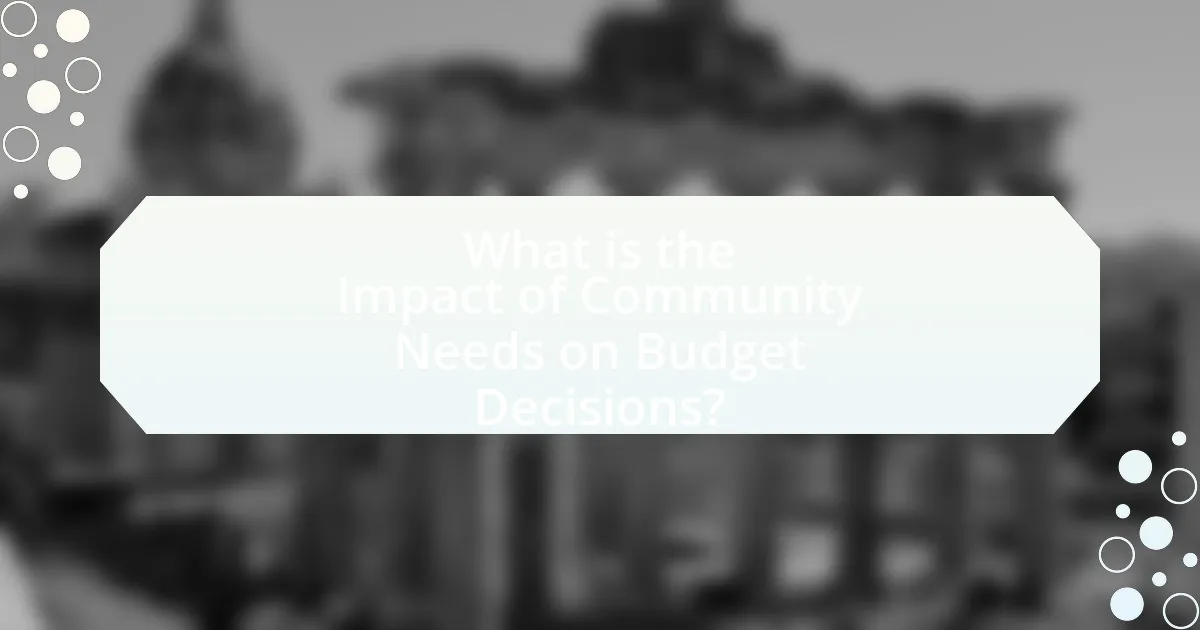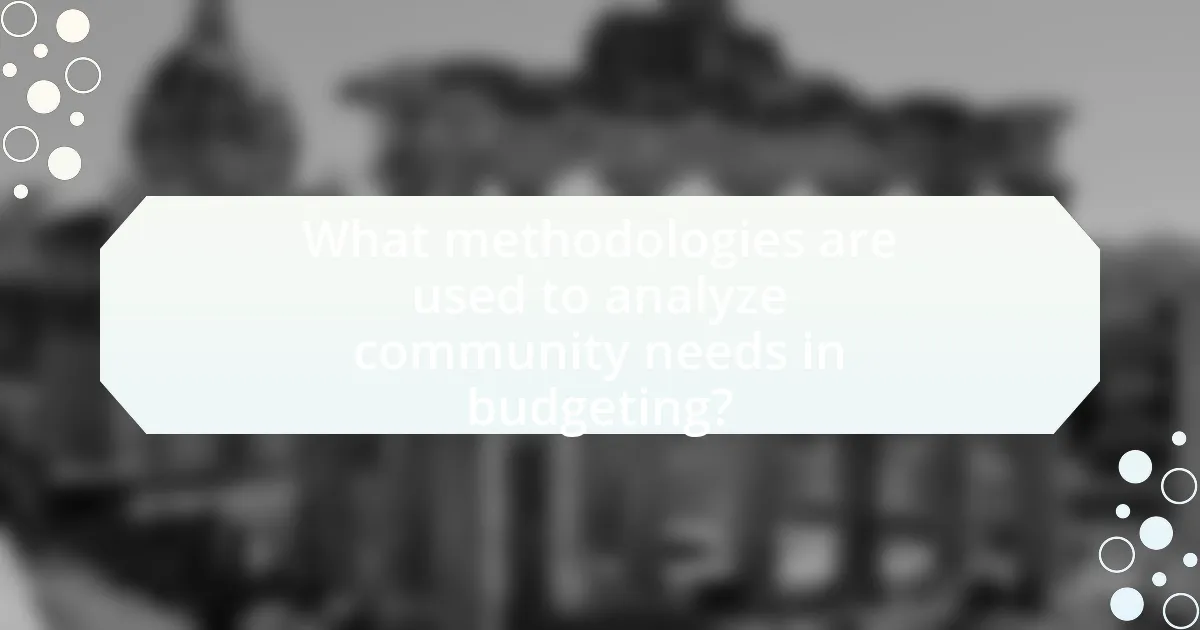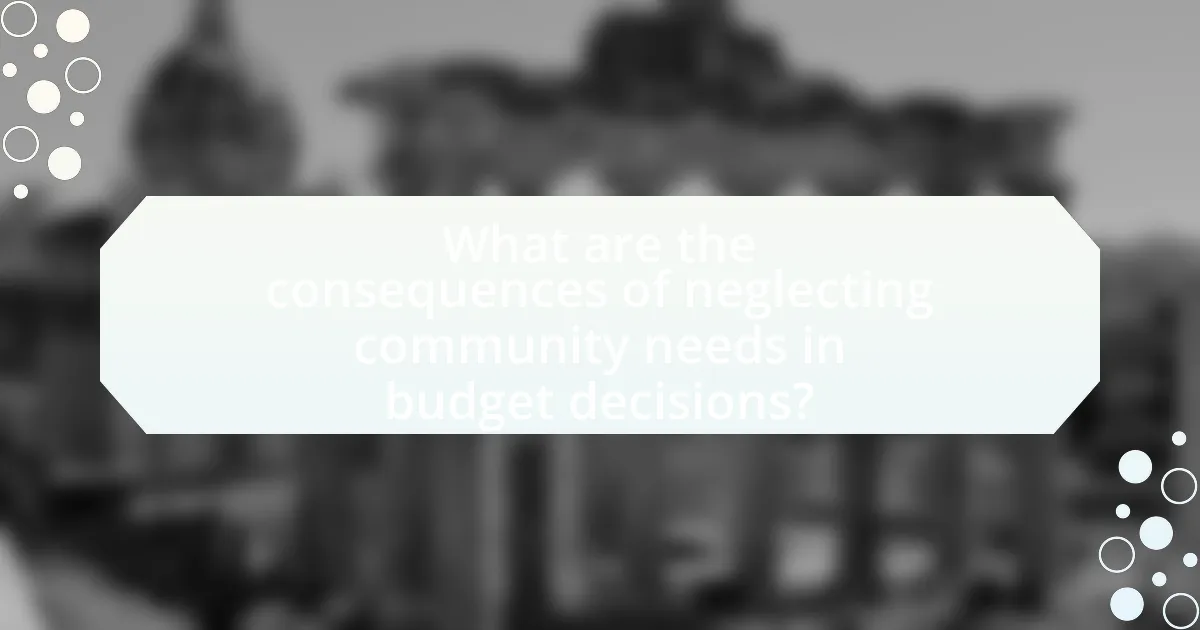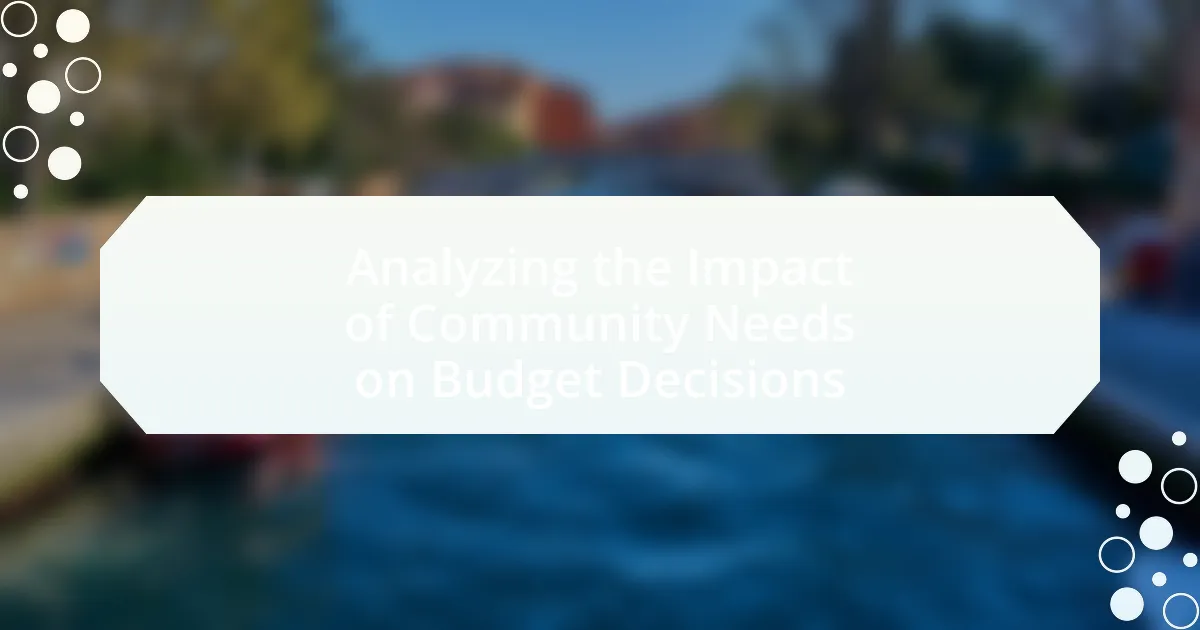The article analyzes the impact of community needs on budget decisions, emphasizing how local governments prioritize resource allocation based on specific local issues such as education, healthcare, and infrastructure. It highlights the importance of community engagement through surveys and public forums in shaping budget priorities, ensuring that financial resources address the most pressing demands of residents. Key community needs, demographic factors, and methodologies for assessing these needs are discussed, along with the consequences of misalignment between budget decisions and community expectations. The article underscores the necessity of integrating community feedback into budget planning to enhance public services and foster civic trust.

What is the Impact of Community Needs on Budget Decisions?
Community needs significantly influence budget decisions by prioritizing resource allocation to address specific local issues. When local governments assess community needs, they often conduct surveys and engage with residents to identify pressing concerns such as education, healthcare, and infrastructure. For instance, a study by the National League of Cities found that cities that actively involve community input in budget planning are more likely to allocate funds effectively, resulting in improved public services and increased resident satisfaction. This demonstrates that understanding and responding to community needs directly shapes budgetary priorities and outcomes.
How do community needs influence budget priorities?
Community needs significantly influence budget priorities by directing financial resources toward essential services and programs that address those needs. Local governments and organizations assess community demands through surveys, public meetings, and demographic data, which reveal priorities such as education, healthcare, infrastructure, and public safety. For instance, a community facing high unemployment may prioritize job training programs, while a neighborhood with inadequate healthcare access may allocate more funds to clinics and health services. This alignment ensures that budget decisions reflect the most pressing issues faced by residents, ultimately leading to improved quality of life and community well-being.
What are the key community needs that affect budget decisions?
Key community needs that affect budget decisions include public safety, education, healthcare, infrastructure, and social services. Public safety demands funding for police, fire departments, and emergency services, which are essential for community well-being. Education requires budget allocation for schools, teachers, and educational programs to ensure quality learning environments. Healthcare needs drive investments in hospitals, clinics, and public health initiatives to maintain community health standards. Infrastructure demands funding for roads, public transportation, and utilities to support economic growth and accessibility. Lastly, social services, including housing assistance and food programs, require budget considerations to address poverty and support vulnerable populations. These needs are often prioritized based on community surveys, demographic data, and local government assessments, influencing how budgets are allocated to meet the most pressing demands.
How do demographic factors shape community needs?
Demographic factors shape community needs by influencing the composition and characteristics of the population, which in turn affects the demand for services and resources. For instance, communities with a higher percentage of elderly residents may require more healthcare services and accessible transportation options, while areas with a significant youth population may prioritize educational facilities and recreational programs. According to the U.S. Census Bureau, demographic shifts, such as aging populations or increasing diversity, directly correlate with changes in community service requirements, highlighting the necessity for tailored budget allocations to meet these evolving needs.
Why is understanding community needs essential for effective budgeting?
Understanding community needs is essential for effective budgeting because it ensures that financial resources are allocated to areas that directly address the priorities and challenges faced by the community. When budget decisions are informed by the specific needs of the population, such as healthcare, education, and infrastructure, it leads to more efficient use of funds and greater satisfaction among community members. For instance, a study by the National League of Cities found that cities that engage with their residents in the budgeting process are more likely to see improved outcomes in public services and increased trust in local government. This demonstrates that aligning budgetary decisions with community needs not only enhances service delivery but also fosters civic engagement and accountability.
What role does community engagement play in budget formulation?
Community engagement plays a crucial role in budget formulation by ensuring that the financial decisions reflect the actual needs and priorities of the community. Engaging community members allows for the identification of specific local issues, preferences, and resource allocation priorities, which can lead to more effective and equitable budget outcomes. For instance, studies have shown that municipalities that incorporate community feedback into their budgeting processes often experience increased public satisfaction and trust in government, as evidenced by the success of participatory budgeting initiatives in cities like Porto Alegre, Brazil, where citizen involvement led to significant improvements in public services.
How can misalignment between community needs and budget decisions lead to issues?
Misalignment between community needs and budget decisions can lead to significant issues such as resource misallocation, decreased public trust, and unmet essential services. When budget decisions do not reflect the actual needs of the community, funds may be directed toward projects that do not address pressing local concerns, resulting in wasted resources. For instance, a community may prioritize healthcare services, but if the budget allocates funds to infrastructure instead, residents may experience deteriorating health outcomes. Additionally, this disconnect can erode public trust in local government, as citizens may feel their voices are not heard or valued, leading to lower civic engagement and participation in future decision-making processes. Studies have shown that communities with aligned budget decisions and needs report higher satisfaction and better overall outcomes, reinforcing the importance of this alignment.

What methodologies are used to analyze community needs in budgeting?
Qualitative and quantitative methodologies are used to analyze community needs in budgeting. Qualitative methods include focus groups, interviews, and community surveys that gather in-depth insights into residents’ priorities and concerns. Quantitative methods involve statistical analysis of demographic data, needs assessments, and surveys that quantify community preferences and resource allocation. For instance, a study by the Urban Institute highlights the effectiveness of combining these methodologies to create a comprehensive understanding of community needs, ensuring that budget decisions are data-driven and reflective of actual demands.
How do surveys and data collection inform budget decisions?
Surveys and data collection inform budget decisions by providing quantitative and qualitative insights into community needs and preferences. These insights enable decision-makers to allocate resources effectively, ensuring that funding aligns with the priorities identified by the community. For instance, a survey conducted by the Pew Research Center in 2021 revealed that 70% of respondents prioritized funding for public health initiatives, which directly influenced local government budget allocations towards healthcare services. By analyzing such data, policymakers can make informed decisions that reflect the actual demands and expectations of the community, ultimately leading to more effective and responsive budgetary outcomes.
What types of surveys are most effective in assessing community needs?
The most effective types of surveys for assessing community needs are quantitative surveys, qualitative surveys, and mixed-method surveys. Quantitative surveys, such as structured questionnaires, provide statistical data that can identify trends and prioritize needs based on numerical analysis. Qualitative surveys, including focus groups and interviews, offer in-depth insights into community perspectives and experiences, allowing for a deeper understanding of specific issues. Mixed-method surveys combine both approaches, leveraging the strengths of quantitative data and qualitative insights to create a comprehensive view of community needs. Research indicates that using a combination of these survey types enhances the accuracy and relevance of the findings, as evidenced by studies showing that communities engaged through multiple survey methods report higher satisfaction with the outcomes and decisions made based on the data collected.
How can data analytics enhance understanding of community priorities?
Data analytics enhances understanding of community priorities by providing actionable insights derived from large datasets that reflect community behaviors, preferences, and needs. By analyzing data from surveys, social media, and public records, local governments and organizations can identify trends and issues that matter most to residents, such as public safety, education, and healthcare access. For instance, a study by the Urban Institute found that data-driven decision-making in community planning led to more effective allocation of resources, aligning budget decisions with the actual needs of the community. This evidence demonstrates that leveraging data analytics not only informs policymakers but also fosters greater community engagement and trust in governance.
What role do public forums and consultations play in this analysis?
Public forums and consultations serve as essential mechanisms for gathering community input in the analysis of budget decisions. They facilitate direct engagement between decision-makers and community members, allowing for the identification of specific needs and priorities that may not be evident through traditional data collection methods. For instance, studies have shown that participatory budgeting processes, which often include public forums, lead to more equitable allocation of resources by reflecting the diverse perspectives of community stakeholders. This engagement not only enhances transparency but also fosters a sense of ownership among residents, ultimately leading to more informed and responsive budgetary outcomes.
How can community feedback be effectively integrated into budget planning?
Community feedback can be effectively integrated into budget planning by utilizing structured engagement methods such as surveys, public forums, and focus groups. These methods allow local governments and organizations to gather diverse perspectives on community needs and priorities. For instance, a study by the International City/County Management Association found that jurisdictions that actively solicit community input during the budget process see increased public trust and satisfaction, leading to more informed and responsive budget allocations. By systematically analyzing this feedback, decision-makers can align budgetary resources with the actual needs of the community, ensuring that funding addresses the most pressing issues identified by residents.
What challenges arise in gathering community input for budget decisions?
Gathering community input for budget decisions faces several challenges, including lack of engagement, diverse stakeholder interests, and communication barriers. Many community members may feel disconnected from the budgeting process, leading to low participation rates in public meetings or surveys. Additionally, differing priorities among various groups, such as residents, businesses, and advocacy organizations, can complicate consensus-building. Communication barriers, such as jargon or complex financial concepts, can further alienate community members, making it difficult for them to provide informed input. These challenges hinder effective collaboration and may result in budget decisions that do not fully reflect community needs.

What are the consequences of neglecting community needs in budget decisions?
Neglecting community needs in budget decisions leads to social discontent and deteriorating public services. When budget allocations do not reflect the priorities of the community, essential services such as education, healthcare, and infrastructure suffer, resulting in increased inequality and reduced quality of life. For instance, a study by the Urban Institute found that communities with underfunded public services experience higher crime rates and lower educational outcomes, demonstrating a direct correlation between budget neglect and community well-being. Additionally, ignoring community input can erode trust in local government, leading to decreased civic engagement and participation in future decision-making processes.
How can inadequate budget responses affect community well-being?
Inadequate budget responses can significantly undermine community well-being by limiting access to essential services and resources. When budgets fail to address critical needs such as healthcare, education, and infrastructure, communities experience increased poverty rates, reduced quality of life, and heightened social disparities. For instance, a study by the Urban Institute found that communities with underfunded public services face higher rates of unemployment and crime, illustrating the direct correlation between budget allocations and community health outcomes. Therefore, insufficient budget responses can lead to long-term detrimental effects on the overall stability and prosperity of communities.
What are the long-term impacts of ignoring community needs?
Ignoring community needs leads to long-term social and economic decline. When community needs are overlooked, essential services such as healthcare, education, and infrastructure deteriorate, resulting in increased poverty and reduced quality of life. For instance, a study by the Urban Institute found that communities lacking adequate investment in public services experience higher crime rates and lower educational attainment, which perpetuates cycles of disadvantage. Additionally, neglecting community needs can erode trust in local government, leading to decreased civic engagement and participation, further exacerbating the disconnect between residents and decision-makers. This cycle of neglect ultimately hinders sustainable development and community resilience.
How does community dissatisfaction influence future budget cycles?
Community dissatisfaction significantly influences future budget cycles by prompting local governments to reassess funding priorities and allocate resources more effectively. When community members express dissatisfaction, often through public forums or surveys, it signals to decision-makers that current budget allocations may not meet the needs or expectations of constituents. For instance, a study by the International City/County Management Association found that municipalities experiencing high levels of public discontent often adjust their budgets to address specific concerns, such as public safety or infrastructure improvements, in subsequent cycles. This responsiveness can lead to increased transparency and community engagement in the budgeting process, ultimately shaping future fiscal strategies to better align with community needs.
What strategies can be implemented to align budget decisions with community needs?
To align budget decisions with community needs, governments and organizations can implement participatory budgeting, which involves engaging community members in the budget allocation process. This strategy allows residents to voice their priorities and preferences, ensuring that funding reflects the actual needs of the community. Evidence from cities like Porto Alegre, Brazil, shows that participatory budgeting can lead to increased public satisfaction and more equitable resource distribution, as it directly incorporates citizen input into financial planning. Additionally, conducting regular needs assessments through surveys and community forums can provide data-driven insights that inform budgetary decisions, further enhancing alignment with community priorities.
How can local governments prioritize community needs in their budgets?
Local governments can prioritize community needs in their budgets by conducting comprehensive needs assessments that involve community engagement and data analysis. This process allows local governments to identify the most pressing issues faced by residents, such as public safety, education, and infrastructure. For instance, a study by the National League of Cities found that cities that actively involve citizens in budget discussions are more likely to allocate funds effectively to meet community priorities. By utilizing surveys, public forums, and stakeholder meetings, local governments can gather valuable input that informs budget allocations, ensuring that resources are directed toward areas that will have the greatest impact on community well-being.
What best practices can ensure ongoing community engagement in budget processes?
To ensure ongoing community engagement in budget processes, implementing regular public forums and feedback mechanisms is essential. These practices allow community members to voice their opinions and concerns, fostering transparency and trust. For instance, cities like Seattle have successfully utilized participatory budgeting, where residents directly influence budget allocations, resulting in increased civic participation and satisfaction. Additionally, utilizing digital platforms for surveys and discussions can reach a broader audience, ensuring diverse community representation. Research indicates that consistent engagement leads to better alignment of budget priorities with community needs, ultimately enhancing the effectiveness of public spending.
What are practical steps for effectively analyzing community needs for budget decisions?
To effectively analyze community needs for budget decisions, conduct a comprehensive needs assessment that includes data collection, stakeholder engagement, and prioritization of needs. First, gather quantitative and qualitative data through surveys, interviews, and focus groups to understand the specific needs of the community. For instance, the U.S. Census Bureau provides demographic data that can inform budgetary priorities. Next, engage with community stakeholders, including residents, local organizations, and government officials, to gather diverse perspectives and insights. This engagement ensures that the analysis reflects the community’s priorities. Finally, prioritize the identified needs based on factors such as urgency, impact, and available resources, using frameworks like the SWOT analysis (Strengths, Weaknesses, Opportunities, Threats) to guide decision-making. This structured approach ensures that budget decisions are aligned with the actual needs of the community, leading to more effective resource allocation.

Leave a Reply